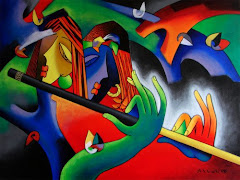Diwali being a dry day in Delhi, I decided to try the white liquor.
Aroma was mild (looks can be deceptive). I thought, Korea being inhabited by a race stock similar to us, could be producing similar kinds of local liquor available at home. So I was surprised, when the Jinro did not smell a bit like Sekmai or Andro or Pheiyeng or farther away from home like Sake or Lao Khao from Thailand. The pungent or the sometimes “nasty” smell of our local liquor was missing from Jinro.
Diwali is a day of worship, prayer and devotion for prosperity, and thus, we’re taught from childhood to refrain from non-vegetarian food. But the lure of the aroma of Jinro compelled me for a mouth watering pork-chop or some fried fishes. I landed up with some crisply fried (double) buff meat.
The aroma of Jinro was mild. Yet, ingrained experiences compelled me to block my nostrils when I lifted the first serving to my lips. I remember my first encounter with Andro zu. In sheer bravado, I followed the footsteps of the experienced and gulped down a 250 ml of liquor, neat, and without blocking my nostrils. I thought my tastebuds and olfactory nerves have dried up. Since then, I make it a point to block my nostril whenever I take any white liquor including white wine.
Ummm, there was an unfamiliar sensation tickling my taste buds. Jinro was too sweet to be an alcoholic drink. Even ready to drink (RTD) alcoholic beverages including wine carries the familiar taste of alcohol – call it bitter or hard. Slowly I relaxed my nostril and allowed the sweet and smooth drink to slowly run down my gullet after rolling for a while in my mouth. Recherché!
Jinro & Soju
Fifteen minutes of Google search produced what I was looking for.
Jinro is a distiller in South Korea, founded in 1924. It is the world's leading producer of Soju, accounting for more than half of that beverage's domestic sales. In the year 2007, 72 million cases were sold as per Business Outlook (“Asian Booze Brands Outsell Western Alcohol”, August 2007).
It also manufactures a variety of other alcoholic beverages including red wine and whiskey. In 2006, the company was taken over by Hitte, in a manner similar to United Brewers India’s acquisition of Shaw Wallace. However brands come out in market under respective original names. For example, Royal Challenge, an original produce of Shaw Wallace, enters the market in the very name. In manufacturer’s name one would find both Shaw Wallace as well as United Spirit. Thus, the label of Jinro on the bottle of my white liquor; Hitte must be hidden somewhere in Korean text.
Few more phone calls confirmed that what I had with me was Soju (a sweet variant of Korean vodka), a romanised name of traditional Hangul or Hanja. Soju is sometimes referred to as Korea's Sake. The main ingredient for Soju – known to Koreans as "a friend of life" - is rice as well as sweet potato/tapioca, barley, sugar and wheat. The clear liquid has a varied alcohol content: from 20 to 40 per cent. In olden days, Soju was was used as for medicinal purposes – to deal with stress or taken after a hard day’s work (we too call our local liquor “hidak” meaning medicine).
Traditionally, the process of making Soju begins with steamed rice cooled with cold water and then mashed with fermented glutinous rice. After a good stir, this blend is kept about a week to ferment and then boiled. A distilled alcohol forms on the surface after the mixture is dumped with cold water. This manufacturing process is similar to our local liquor.
Soju is usually served straight and in a shot glass (like Sekmai or Andro). As is Korean custom, you do not fill your own glass, others are expected to spot your empty glass and to fill it. Also, out of respect, you do not down your liquor in front of someone senior to you (in age and in professional terms). You should face away and drink.
Even though Soju is meant to be drunk straight, Koreans have their Soju cocktails. Often the liqueur is mixed with Sprite or syrup. Another cocktail involves mixing the drink with two parts Sprite and lemonade powder. Watermelon and apple Soju are also popular drinks.
Spirit scenario in India
I am presently working on a project that relates to spirit (hard liquor excluding wine and beer) (Indian Made Foreign Liquor as well as country liquor) in India. Basically, objective of the study is to identify number of caps and closures used by spirit bottles in India. That demands, first of all, to identify number of cases (of different pack sizes such as 60 ml, 90 ml, 180 ml, 375 ml, 750 ml, 1000 ml, 2000 ml) of spirit consumed in India (manufactured as well as imported and exported). Nowadays, United Spirit has introduced tetrapack (sachet/pouches) for whisky in Karnataka. Once we’ve this reference point, remaining part of the study is easy.
Our initial findings indicate that Indian spirit market is highly organized and dominated by players such as United Spirits, Seagram’s, Diageo, Radico Khaitan, Pernod Ricard, Allied Domecq, and so on. Different forms of spirits are sold in the Indian market which includes whisky, rum, vodka, brandy, gin and so on. Break up of the different spirits consumed in Indian market is Whisky (55 to 60%), Rum (15 to 20%), Vodka (10 to 12%), Brandy (8 to 10%) and Gin (5 to 7%).
Country liquor is essentially made of rectified spirit through fermentation and rectification of molasses or fermented grains (rice, barley, wheat) or fruit (such as cashew nut and date palm). This do not undergo multiple distillation, as is the case of spirits / IMFL, leaving it with a higher content of untreated or low quality alcohol. This could induce an instant kick in a mal-nourished or under-nourished consumer, which the segment mainly caters to.
Total consumption of country liquor in India in the year 2007 was estimated between 180 to 200 million cases. Obviously, we could not include variant of local liquors widely used in the Northeast India. Country liquor market in India is highly fragmented and several small players are into the manufacturing of the country liquor. Country liquor is primarily produced in the states of Maharashtra and Uttar Pradesh. Southern states and Manipur, Nagaland, Mizoram and others have prohibited the sale and consumption of country liquor. However, bottlegging is widely practiced in these states.
Sekmai, Andro, Pheiyeng & Zu khuns: Sorry state if liquor in Manipur
Liquor is serious business, not to mention certain ceremonies and traditions assigned to the culture of drinking. While embracing Hinduism led to prohibition for more than a decade (at the same time Meetei Kings demanded Kabuis to brew Zu for Kuki regiments at Imphal and surrounding area) in Manipur valley, the introduction of tea as form of beverages by colonial British in hill areas led to disruption in using alcohol as welcome drinks.
Resurgence in consumption of alcohol is usually contextualized with the Second World War. Since then, Manipur has not looked back. However, the present blanket ban by AMADA has halted public consumption. However, as I mentioned earlier, illicit consumption goes on.
Menace of alcohol springs largely from binge drinking. Personally, I can not advocate consumption of alcohol other than romanticizing or giving an eulogy. However, Sake or Soju or Russian Vodka (vodka means water in Russian) invokes jealousy within me. Makes me question why the hell, we cannot refine our distillery and make them export items.
State excise departments which vigilantly look after alcohol policy in every state in India can find ways to institute a workable policy, keeping public health as well a strict societal control in Manipur. But proposing a business strategy to develop Sekmai, Andro, Pheiyeng and so on as SEZs for country liquor on my part would be like committing hara kiri, given the serious movement against alcohol in Manipur.
This brings me down to Soju again. Drink in my own privacy and listen quietly to Sekmai Chamelli by Naba Volcano.
 Often heard about them
Often heard about them










